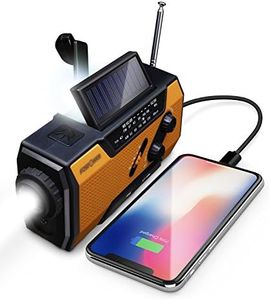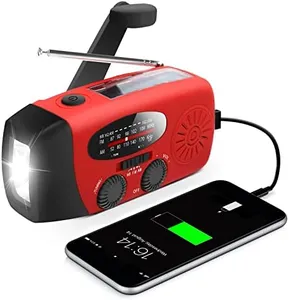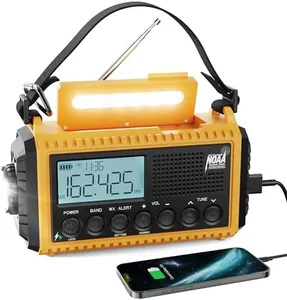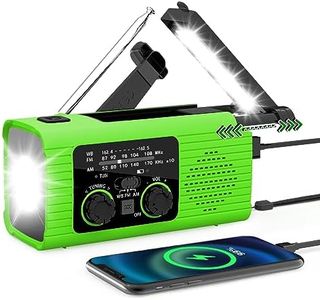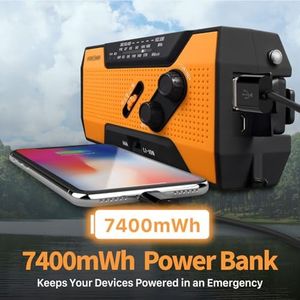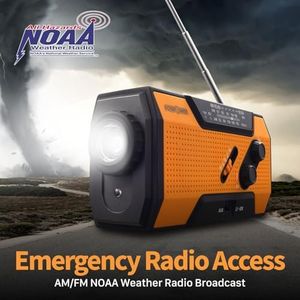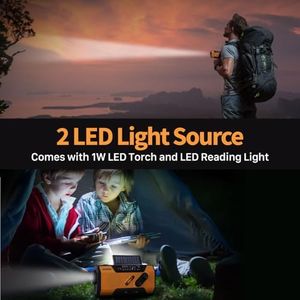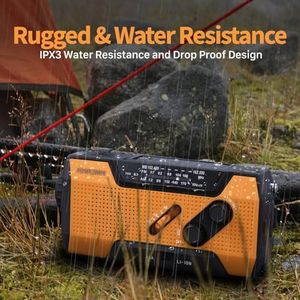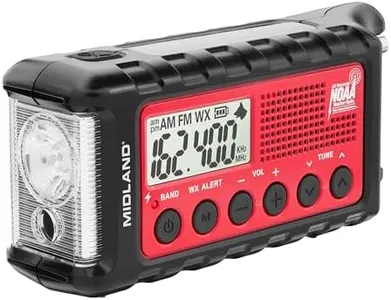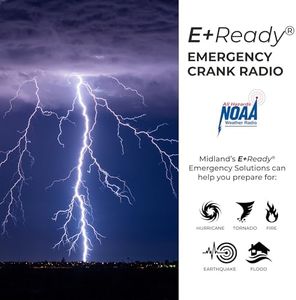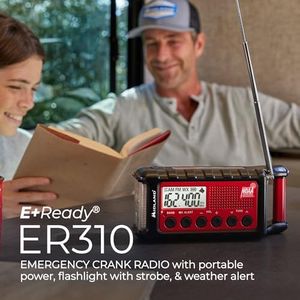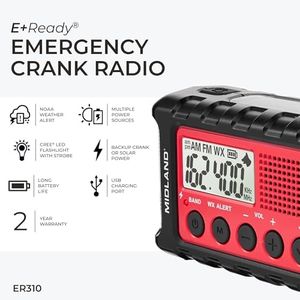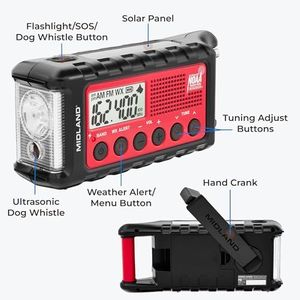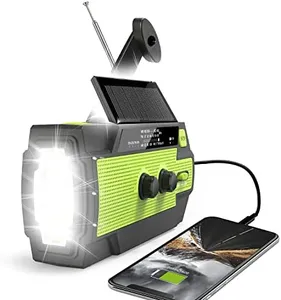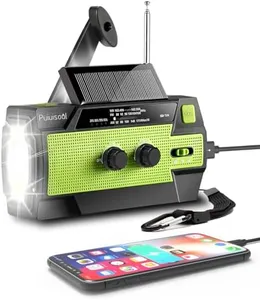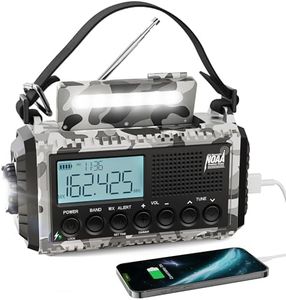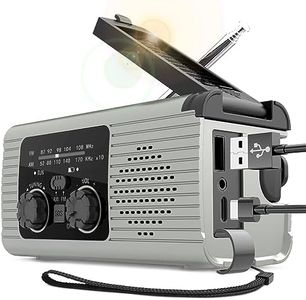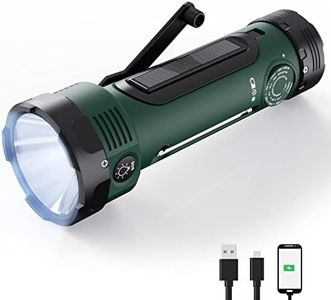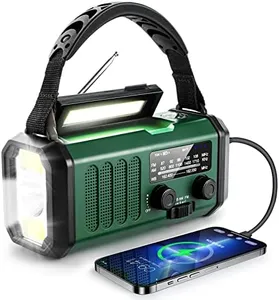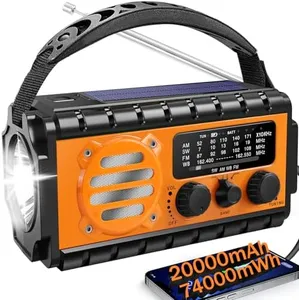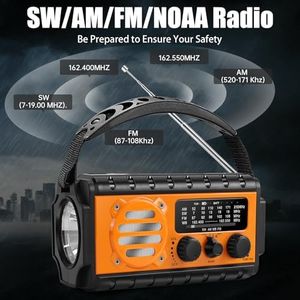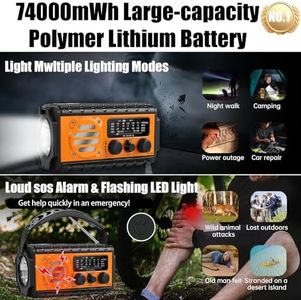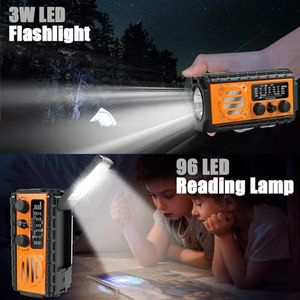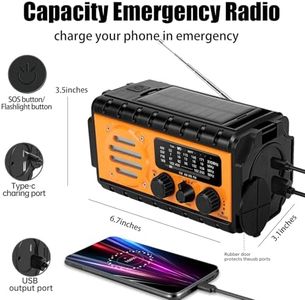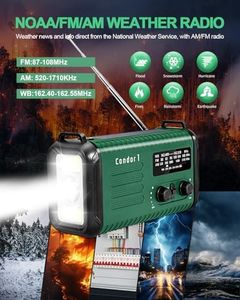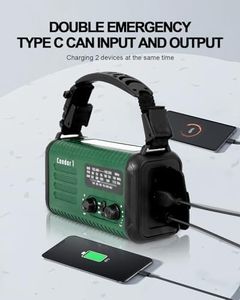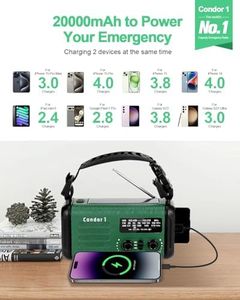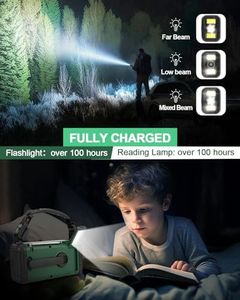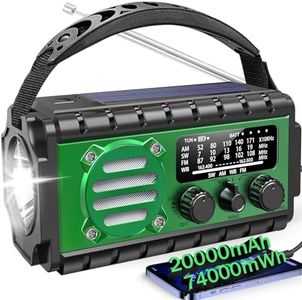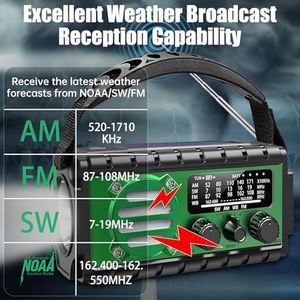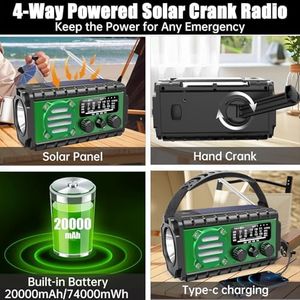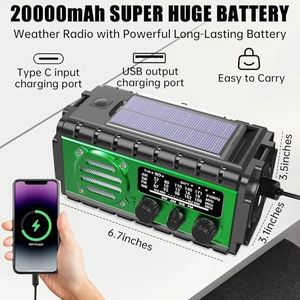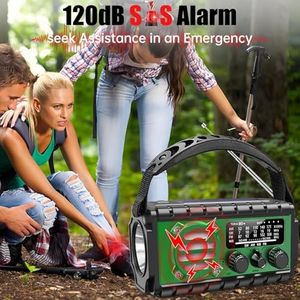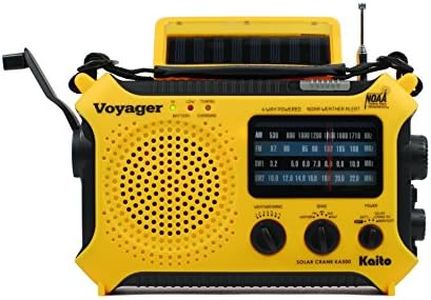10 Best Solar Powered Emergency Radios 2025 in the United States
Winner
FosPower Emergency Weather Radio (Model A1) NOAA/AM/FM with 7400mWh Portable Power Bank, USB/Solar/Hand Crank Charging, Battery Operated, SOS Alarm & Flashlight for Indoor/Outdoor Emergencies
The FosPower Emergency Weather Radio (Model A1) offers a balanced mix of features and practicality, making it a solid choice for emergency preparedness both indoors and outdoors. One of its standout features is the 7400mWh (2000mAh) power bank, which is useful for charging small devices like phones or tablets in a pinch. This radio provides three power sources — solar, hand crank, and AAA batteries — ensuring you can keep it operational under various circumstances. The solar panel and hand crank allow for regenerative power, which is particularly beneficial during extended power outages or when you're off the grid.
Most important from
35993 reviews
Emergency Hand Crank Radio with LED Flashlight for Emergency, AM/FM NOAA Portable Weather Radio with 2000mAh Power Bank Phone Charger, USB Charged & Solar Power for Camping, Emergency
This emergency hand crank radio is a compact and lightweight device designed for safety during natural disasters and power outages. It supports AM, FM, and NOAA weather bands, allowing you to receive important weather alerts and updates, which is essential for staying informed in emergencies. Its standout feature is the 3-way power system: it can be charged by hand cranking, solar power, or a built-in rechargeable 2000mAh battery. This flexibility ensures the radio can keep working even if regular batteries or electricity are unavailable. The built-in 2000mAh battery also doubles as a phone charger via USB, which could be a lifesaver when you need to make emergency calls.
Most important from
21807 reviews
Raynic Emergency Radio, 5000mAh/18500mWh Weather Radio, Solar Hand Crank Radio with AM/FM/SW/NOAA Alert, Cell Phone Charger, Headphone Jack, Flashlight and SOS Siren
The Raynic Emergency Radio is a versatile and reliable choice for emergencies, particularly weather-related ones. One of its greatest strengths is the variety of power sources it offers, including solar, hand crank, rechargeable battery, AAA batteries, USB input, and an AC adapter. This ensures that you can keep the radio powered up in nearly any situation. The 5000mAh battery also doubles as a cell phone charger, which is a significant plus in emergencies. Battery life is commendable, providing long durations of use without needing constant recharging. The radio supports multiple bands, including AM, FM, SW, and NOAA, making it a comprehensive tool for staying informed about weather conditions and alerts.
Most important from
17069 reviews
Top 10 Best Solar Powered Emergency Radios 2025 in the United States
Winner
9.8 score
FosPower Emergency Weather Radio (Model A1) NOAA/AM/FM with 7400mWh Portable Power Bank, USB/Solar/Hand Crank Charging, Battery Operated, SOS Alarm & Flashlight for Indoor/Outdoor Emergencies
FosPower Emergency Weather Radio (Model A1) NOAA/AM/FM with 7400mWh Portable Power Bank, USB/Solar/Hand Crank Charging, Battery Operated, SOS Alarm & Flashlight for Indoor/Outdoor Emergencies
Chosen by 1313 this week
Emergency Hand Crank Radio with LED Flashlight for Emergency, AM/FM NOAA Portable Weather Radio with 2000mAh Power Bank Phone Charger, USB Charged & Solar Power for Camping, Emergency
Emergency Hand Crank Radio with LED Flashlight for Emergency, AM/FM NOAA Portable Weather Radio with 2000mAh Power Bank Phone Charger, USB Charged & Solar Power for Camping, Emergency
Raynic Emergency Radio, 5000mAh/18500mWh Weather Radio, Solar Hand Crank Radio with AM/FM/SW/NOAA Alert, Cell Phone Charger, Headphone Jack, Flashlight and SOS Siren
Raynic Emergency Radio, 5000mAh/18500mWh Weather Radio, Solar Hand Crank Radio with AM/FM/SW/NOAA Alert, Cell Phone Charger, Headphone Jack, Flashlight and SOS Siren
Midland - ER310, Emergency Crank Weather AM/FM Radio - Multiple Power Sources, SOS Emergency Flashlight, Ultrasonic Dog Whistle, & NOAA Weather Scan + Alert (Red/Black)
Midland - ER310, Emergency Crank Weather AM/FM Radio - Multiple Power Sources, SOS Emergency Flashlight, Ultrasonic Dog Whistle, & NOAA Weather Scan + Alert (Red/Black)
Emergency Crank Weather Radio, 4000mAh Solar Hand Crank Portable AM/FM/NOAA, with 1W 3 Mode Flashlight & Motion Sensor Reading Lamp, Cell Phone Charger, SOS for Home and Emergency Green
Emergency Crank Weather Radio, 4000mAh Solar Hand Crank Portable AM/FM/NOAA, with 1W 3 Mode Flashlight & Motion Sensor Reading Lamp, Cell Phone Charger, SOS for Home and Emergency Green
10000mAh Hand Crank Emergency Radio, NOAA Weather Radio with AM/FM & solar Radio, Rechargeable Battery, Flashlight & Reading Light, SOS Alarm, Compass Cell Phone Charger for Indoor Outdoor Emergencies
10000mAh Hand Crank Emergency Radio, NOAA Weather Radio with AM/FM & solar Radio, Rechargeable Battery, Flashlight & Reading Light, SOS Alarm, Compass Cell Phone Charger for Indoor Outdoor Emergencies
QAUYYW 74000mWh Emergency Radio with NOAA Weather, Portable Hand Crank SW/AM/FM Survival Radio with Fast Charge Rechargeable Solar Battery, Flashlight, Reading Lamp,SOS Sirenor Home Outdoor
QAUYYW 74000mWh Emergency Radio with NOAA Weather, Portable Hand Crank SW/AM/FM Survival Radio with Fast Charge Rechargeable Solar Battery, Flashlight, Reading Lamp,SOS Sirenor Home Outdoor
7.6 score
Our technology thoroughly searches through the online shopping world, reviewing hundreds of sites. We then process and analyze this information, updating in real-time to bring you the latest top-rated products. This way, you always get the best and most current options available.

